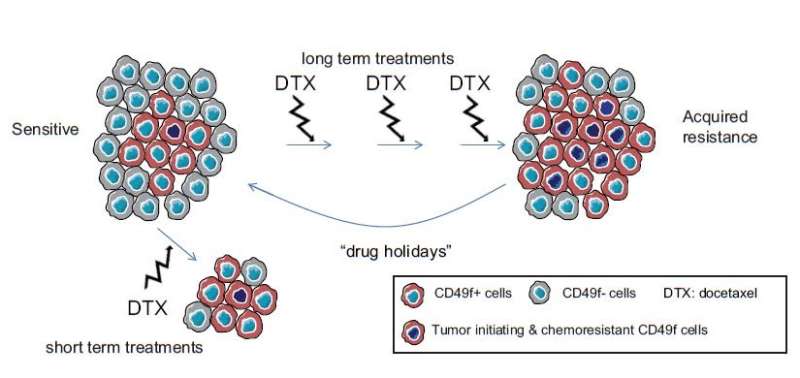Researchers find chemoresistance in breast cancer is related to varying tumor cell populations

Researchers from the transformation and metastasis group of the Bellvitge Biomedical Research Institute (IDIBELL), led by Dr. Eva González-Suárez, have recreated and characterized the development of resistance to chemotherapy in orthotopic animal models of breast cancer, presenting the possibility of reversing resistance after a period of rest from the treatment. The paper has been published by Stem Cell Reports.
Taxane chemotherapy is one of the most common therapeutic options in breast cancer; however, its effectiveness usually decreases progressively until it reaches a point at which the treatment must be modified. Working with animal models, the researchers observed that breast tumors that do not express hormone receptors—called triple negatives—are more sensitive to taxane chemotherapy than luminal tumors, which are generally more resistant. As seen in clinical practice, after multiple rounds of treatment, triple negative tumors acquired resistance to the drug.
"However, when we kept these animals for long periods without the drug, we saw that sensitivity was restored," says Dr. Eva González-Suárez. It is a process known as "drug holidays," that is, sensitive resistant tumors will lose resistance after a long period without the drug.
Based on these results, the researchers hypothesized the existence of other cellular populations in the tumor, some more sensitive and some more resistant, whose balance might be modified based on the presence or absence of treatment and its duration. In fact, results show that resistance to taxanes in triple negative tumors is associated with the dynamics of a CD49f+ cell population, which has a greater capacity for tumor initiation and can therefore lead to relapses after chemotherapy.
"We wanted to know if those resistant tumor cells that we see in greater proportion in resistant tumors (CD49f+) have appeared de novo or by selection of cell populations," explains Dr. González-Suárez. To do so, they treated sensitive tumors with taxanes and found that these resistant cells already existed in the tumors and their proportion to the sensitive cells increased in the residual disease precisely because of its chemoresistance capacity. "The results suggest that the CD49f+ population is associated with resistance to docetaxel in most of triple negative tumors, which is notorious considering the great heterogeneity of this subtype," adds the IDIBELL researcher.
In cancer patients, once resistance develops, doctors switch the patient to a different treatment, so it is not yet known whether a drug holiday period would work. "Given that breast cancer relapses happen after a long time—about 10 to 20 years in luminal tumors and three to five years in the triple negative ones, perhaps this time window would be long enough to return to taxane therapies, even when the patient had previously developed resistance, especially considering that these therapies are the only treatments currently available for this disease," says the doctor.
In order to carry out this work, IDIBELL researchers have developed PDX animal models, also known as ortoxenografts, placing samples of breast cancer patients in immunosuppressed mice. "It's not an easy process, and efficiency is very low," says Eva Gonzalez-Suarez. "However, unlike other studies performed on cell lines or patient samples that are very difficult to obtain, working with PDX models allows for enough paired samples that are sensitive and resistant to a particular drug."
These sensitive/resistant paired models have led to the identification of a genetic signature associated with resistance in triple negative disease, that is, in those tumors that do not disappear after treatment with chemotherapy. "This signature can help us predict whether patients will respond to chemotherapy or not in a personalized way," concludes Gonzalez-Suarez.
More information: Stem Cell Reports (2017). DOI: 10.1016/j.stemcr.2017.03.026
















